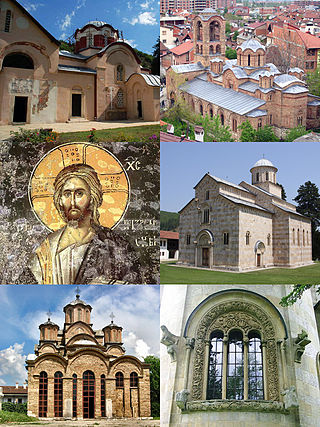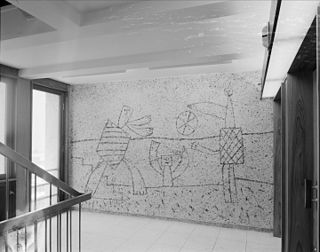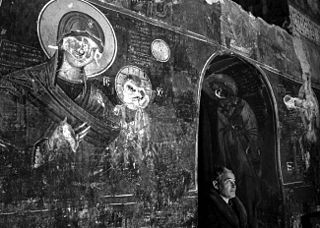
A World Heritage Site is a landmark or area with legal protection by an international convention administered by the UNESCO. World Heritage Sites are designated by UNESCO for having cultural, historical, scientific or other forms of significance. The sites are judged to contain "cultural and natural heritage around the world considered to be of outstanding value to humanity".

The International Union for Conservation of Nature (IUCN) is an international organization working in the field of nature conservation and sustainable use of natural resources. Founded in 1948, IUCN has become the global authority on the status of the natural world and the measures needed to safeguard it. It is involved in data gathering and analysis, research, field projects, advocacy, and education. IUCN's mission is to "influence, encourage and assist societies throughout the world to conserve nature and to ensure that any use of natural resources is equitable and ecologically sustainable".

Conservation in the Republic of Ireland is overseen by a number of statutory and non-governmental agencies, including those with responsibility for conservation of the built environment and conservation of the natural environment in Ireland. Conservation has sometimes been a contentious issue, with debates impacting its progress since the 1960s. Concrete initiatives are sometimes driven by European Union (EU) heritage protection and environmental policies, including EU environmental law, which – as a member – the Irish government is obliged to adopt and implement.
The International Council on Monuments and Sites is a professional association that works for the conservation and protection of cultural heritage places around the world. Now headquartered in Charenton-le-Pont, France, ICOMOS was founded in 1965 in Warsaw as a result of the Venice Charter of 1964 and offers advice to UNESCO on World Heritage Sites.

Historic preservation (US), built heritage preservation or built heritage conservation (UK) is an endeavor that seeks to preserve, conserve and protect buildings, objects, landscapes or other artifacts of historical significance. It is a philosophical concept that became popular in the twentieth century, which maintains that cities as products of centuries' development should be obligated to protect their patrimonial legacy. The term refers specifically to the preservation of the built environment, and not to preservation of, for example, primeval forests or wilderness.

The Visoki Dečani Monastery is a medieval Serbian Orthodox Christian monastery located near Deçan, Kosovo. It was founded in the first half of the 14th century by Stefan Dečanski, King of Serbia. It is often considered to be one of the most endangered European cultural heritage sites. It is by far the largest medieval church in the Balkans, hence its translated name, High Dečani.

The Blue Shield, formerly the International Committee of the Blue Shield, is an international organization founded in 1996 to protect the world's cultural heritage from threats such as armed conflict and natural disasters. Originally intended as the "cultural equivalent of the Red Cross", its name derives from the blue shield symbol designed by Jan Zachwatowicz, used to signify cultural sites protected by the 1954 Hague Convention for the Protection of Cultural Property in Armed Conflict.

The Medieval Monuments in Kosovo are a World Heritage Site consisting of four Serbian Orthodox Christian churches and monasteries which represent the fusion of the eastern Orthodox Byzantine and the western Romanesque ecclesiastical architecture to form the Palaiologian Renaissance style. The construction was founded by members of Nemanjić dynasty, the most important dynasty of Serbia in the Middle Ages. The sites are located in Kosovo.

The Amphitheatre of Durrës is a Roman amphitheatre in the centre of the city of Durrës, Albania. Construction began under the emperor Trajan in the 2nd century AD and it was destroyed twice by earthquakes in the 6th and 10th centuries. It is the largest Roman amphitheatre ever built in the Balkan Peninsula, once having a capacity of 20,000 people.
The Convention for the Protection of the Architectural Heritage of Europe is a legally binding instrument which set the framework for an accurate conservation approach within Europe. For a total of forty three member states of the Council of Europe, the convention's total ratification/accession has reached forty-two countries since it was opened for signature in 1985. It entered into force on 1 December 1987.
The European Heritage Alliance 3.3, an informal European sectoral platform composed of 30 European or international networks and organisations active in the wider field of cultural heritage, was launched in June 2011 on the occasion of the European Heritage Congress 2011 organised by Europa Nostra in Amsterdam.

Picasso's Regjeringskvartalet murals are a series of murals designed by the Spanish artist Pablo Picasso in the late 1950s and the early 1970s. He designed five murals for the Regjeringskvartalet buildings in central Oslo, Norway. The designs by Picasso were executed in concrete by Norwegian artist Carl Nesjar, and were Picasso's first attempt at monumental concrete murals. The buildings onto which the murals were executed are known as the 'H-Block' or Highrise (1959) and 'Y-Block' (1968); they were designed by the Norwegian architect Erling Viksjø. The largest mural, The Fishermen (1970) is on the façade of Y-Block. Picasso would later create works in a similar vein in Barcelona and Stockholm.

Deçan Municipality or Dečani Municipality is a municipality located in the District of Gjakova of Kosovo. The seat is the town of Deçan. According to the 2011 census, the municipality has 40,019 inhabitants, with 3,803 inhabitants in the town of Deçan.
The 7 Most Endangered Programme identifies endangered monuments and sites in Europe and mobilizes public and private partners on a local, national and European level to find a viable future for those sites.

Serbian cultural and religious sites in Kosovo were systematically vandalized and destroyed over several historical periods, during the Ottoman rule, World War I, World War II, Yugoslav communist rule, Kosovo War and 2004 unrest.
Biosphere reserves are areas comprising terrestrial, marine and coastal ecosystems. The biosphere reserve title is handed over by UNESCO. Each reserve promotes solutions reconciling the conservation of biodiversity with its sustainable use. Biosphere reserves are 'Science for Sustainability support sites' – special places for testing interdisciplinary approaches to understanding and managing changes and interactions between social and ecological systems, including conflict prevention and management of biodiversity. Biosphere reserves are nominated by national governments and remain under the sovereign jurisdiction of the states where they are located. Their status is internationally recognized.
Initiative for St. Andrew’s Passage — Ukrainian non-governmental organization (NGO) that was created for consolidation of the numerous civil organizations and initiatives. Its mission is to protect and conserve the historical and cultural heritage as well as the natural environment. In September 2012 Initiative for St. Andrew's Passage was officially recognized by virtue of the State registration and is acting under its own Statute.

Azerbaijan ranks fairly poorly in terms of its commitment to the protection of animal welfare and freedom from suffering. It is ranked 36th out of 50 countries on the Voiceless Animal Cruelty Index. According to the Animal Protection Index, it has not pledged support for the Universal Declaration on Animal Welfare, there is no policy or legislation in the country preventing animal suffering by deliberate acts or negligence, and there are no animal protection laws in reference to animals used in farming. The country does have legislation on the conservation of wild animals, which also apply to animals kept in confinement. It implies a duty of care, in limited situations, but its effectiveness is hard to assess.
The Juminkeko Foundation, or simply Juminkeko, is a Finnish organization founded in 1991. It runs Juminkeko, an eponymous information centre of the national epic Kalevala and Karelian culture located in Kuhmo, Finland. The centre was designed by the Finnish architects Mikko Heikkinen and Markku Komonen and was completed in 1999.













